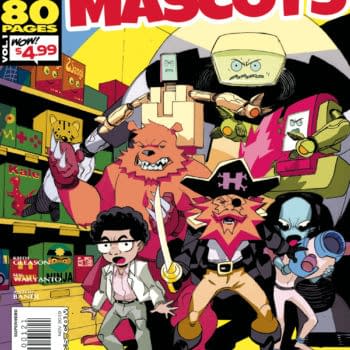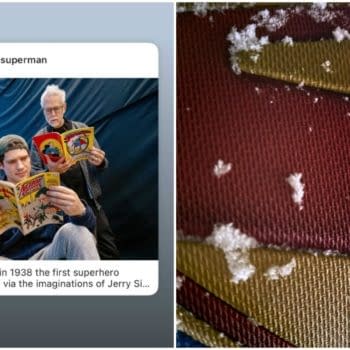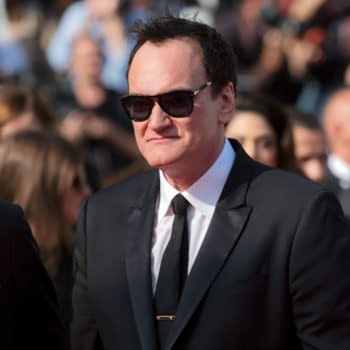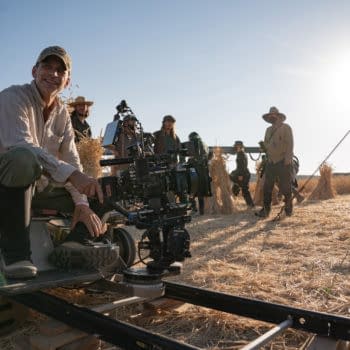Posted in: Movies, Recent Updates | Tagged: act of faith, Alan Moore, his heavy heart, jimmy's end, kickstarter, mitch jenkins, professional relationship, shorts, show, Upon Reflection
Meeting Matchbright, Metterton, James And Faith: Darkness And Light In Moore And Jenkins' The Show
Hannah Mears-Shannon writes for Bleeding Cool.
Watching the "Jimmy's End cycle" that will someday, hopefully, become a feature film called The Show from Alan Moore and Mitch Jenkins, gave Rich Johnston genuine nightmares and I can certainly see why. It would be disingenuous of me to say that I wasn't disturbed by watching the first four film pieces, now downloadable for people who backed Moore and Jenkins' Kickstarter for the final part of the cycle, His Heavy Heart.
I watched Act of Faith first, since that follows the recommended order on the Kickstarter page, and it was the first film made, the one that generated the impetus to continue and make a complete cycle.
Based on my reaction to watching this piece, I wasn't sure I could bring myself to view any more that night, wondering, as Johnston says, if the comforts of daylight and a little psychological distance would be better. But, bizarrely – since no one else seems to have confirmed having a similar reaction – this turned out to be the only episode that made me want to sleep with the lights on.
Watching Jimmy's End, Upon Reflection and A Professional Relationship actually came as a profound relief to me, as if they unpacked what I had seen in Act of Faith and gradually turned the lights on one by one.
Act of Faith tracks an evening in the life of Faith Harrington, a reporter who has plenty of secrets well-hidden within the confines of her private life. From joking and talking to friends through to the darker side of her own self-image, she's a relatable character who is both fragile and determined at the same time. The sequence is shot beautifully, the colours are piercing, and the mood is hypnotic, but it's Faith's desperation, and her assessment of her own worth that are painfully haunting. The manner in which she's cast against a backdrop of chance makes the world seem like an incredibly dark place, at best a bad joke and at worst an engineered trap for trusting souls.
That's what gave me pause about wading further into the films in a single evening.
At over 30 minutes in length Jimmy's End, suggests most directly what a feature film of The Show would look and feel like for viewers, and the presage it offers is heartening. After this film, I don't have any doubts about the quality of a feature production, or whether the themes and characters could bear the weight of a full-blown film treatment.
There are excellent cinematic flourishes, as when James Mitchum's accidental arrival at an increasingly enigmatic gentleman's club on a rainy night seems to move in slow motion, but is really a series of relayed moments with his real-time reactions.
Jimmy's End operates without a great deal of explanation; some of those explanations will come later in the following two film segments, but viewing the episode "in the dark" as to what conversations and events might mean for James, or for Faith – who is also present – makes for a compelling tableaux.
It's possible that you're viewing the world of The Show most accurately, or at least most like James, in this sequence. His struggle to understand, and his compassion for Faith are part of the "light" element in the series. And during "the Show" all the lights, literally, come on too.
Upon Reflection, which in narrative sequence comes before Jimmy's End but should be watched afterward, details Faith's arrival at the club. It's shot in a fish-eyed, fixed view from above the bar and consists of biting exposition delivered in the form of dialogue among Mr. Matchbright, Faith, and a few other characters.
It's a tell-all in motion, active and dynamic in nature. Thematically, it could be the "darkest" of the films, but for the viewer, this is enlightenment. We begin to feel we understand Faith much better, even if it's a journey into her inner darkness and suffering. Ironically, Mr. Matchbright, who is a devil-like figure, comes off as dual, both quietly near-sympathetic and aggressively brutal. That duality is surprising, and another way in which the film could be darker, but isn't.
So why not? My guess is that there is a psychologically-angled sympathy for every single character in these pieces of The Show, and as it bleeds through and you begin to "understand," it softens the blow of their darker elements and makes the captors seems as imprisoned as the captives.
The last of the so-far completed pieces in the short film cycle is A Professional Relationship. It's enlightening in the sense that it delves inside the relationship between the performing double-act and general rulers of the club, Mr. Metterton and Mr. Matchbright. Their god-and-devil relationship reveals itself to be comedic, deep, alarmingly human in some ways, and then pretty twisted, due to all of the above.
This relationship also made me wonder how far the rules of the "club" extend into the human world of the films. If they do, it would explain a lot about the lives of Faith and James. As Johnston pointed out, the modified Tarot that Metterton rearranges while talking to Matchbright represent DNA codes, suggesting the implications of their partnership on the physical world.
But in many ways this film short is the least disturbing of the lot – until you think about what the characters are actually saying to each other, that is. They bicker like an old married couple, and both show less than attractive qualities when talking about big picture themes. But so far, this is the final light being turned on. The film might make you wonder if Faith and James form their own kind of strange double-act like Metterton and Matchbright, questioning who needs to be saved from what and why, and who will take on a stronger role, even if temporarily.
For me, Act of Faith was the hardest hitting of the films, a kind of crash-landing into a world a little too recognizable as human for comfort. It disturbs because it makes the viewer care about the character in surprising ways you might not fully see coming.
While the other segments are in many ways incredibly "dark", particularly in their imagery, they never relent in doling out fragments of information that you can use to assemble your own interpretation of narrative and meaning. It's no secret that the viewer is the real storyteller, telling the story they perceive to themselves and trying to make sense of it but as I watched the pieces pile up, I was simply surprised how many of them contained a little light, particularly collectively, when initially I assumed I would be left, for the most part, in the dark.
Hannah Means-Shannon Senior New York Correspondent at Bleeding Cool, writes and blogs about comics for TRIP CITY and Sequart.org, and is currently working on books about Neil Gaiman and Alan Moore for Sequart. She is @hannahmenzies on Twitter and hannahmenziesblog on WordPress. Find her bio here.

















